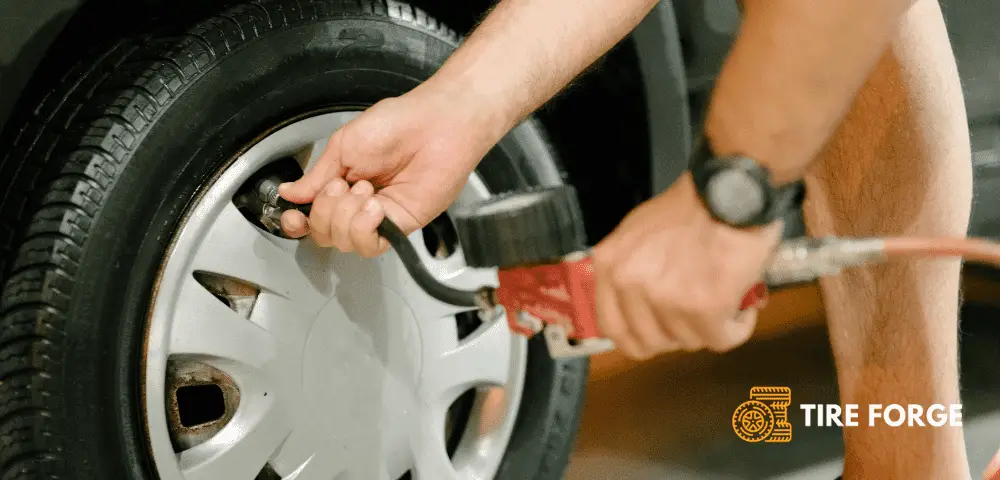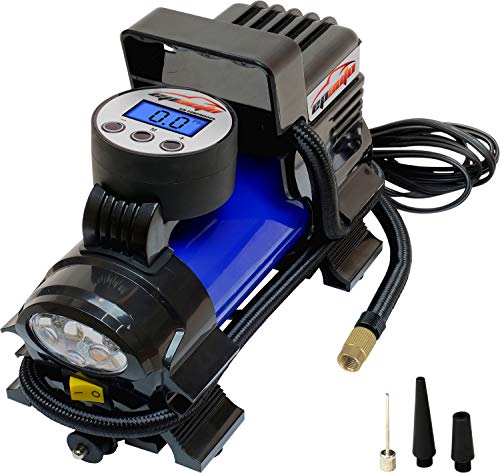With the advent of technology and easy availability of almost any resource, DIY maintenance of cars at home has seen a decline lately.
It is a good thing in a way since people get time for other activities but a little bit of DIY is important, especially concerning tire maintenance.
Underinflated tires can overheat and wear unevenly; overinflated tires can blow out. On the other hand, tires inflated perfectly could fetch better gas mileage.
In this article will be covering exactly that along with putting air in car tires at home.
What you will need to follow in this tutorial?
While filling air into a car’s tires isn’t rocket science, what one needs is information to follow the right procedure, the right set of tools to fill air into the tires, the willingness to put in some physical effort and get those hands dirty.
It is important to understand the tire pressure of a vehicle before following the steps that guide one to fill air into the tires. This can be obtained from the vehicle manufacturer through the vehicle manual or the tire manufacturer can guide with this information.
Also needed for this process is the right equipment and an accurate tire pressure monitor. These will help inflate only that much air that is needed.
Under-inflating or over-inflating the tires could have un- desirable consequences.
How do you fill air in tires at home?
This step-by-step guide will help in the DIY process of filling air in a car’s tires. With the help of this guide, one could choose to be safer by ensuring the tires are filled with the right amount of air.
The following would be handy before one starts the process:
1) Tire Pressure Monitor/ Gauge
2) Tire Inflator/ Tire compressor
3) Car/ Tire user manual
Step 1: Get a correct reading:
The first step is to know how much air exists in the tires. One must use a tire pressure monitor or a gauge to know the tire pressure before filling the tire with air. Connect the monitor/ gauge to the tire and get a reading before following step 2.
Step 2: Refer to the manual
The next step is to know the amount of air pressure specified by the vehicle/tire manufacturer. This information can be obtained from the user manual. Once this is ascertained, it is easy to calculate the amount of air that is required to be filled in.
One has to compare the recommended PSI (set by the manufacturer) with the pressure reading found on the tire pressure monitor.
Then, subtract the current pressure reading on the monitor from the standard PSI. This would fetch the balance PSI reading needed to be filled in.
Step 3: Attach the tire inflator and run it
Attach the tire inflator/ compressor by placing the air hose nozzle fitting on the valve stem and turn it on. A hissing noise should be audible when the air starts flowing through the hose.
In case if one notices air being blown around the stem, chances are that the inflator isn’t attached properly. The inflator must be attached tightly in this case.
Step 4: Check the pressure to ascertain the limit
It is important to keep a watch on the pressure gauge of the inflator/ compressor. Monitoring pressure helps in knowing that the tires are being refilled appropriately.
In case the pressure drops while filling air or, if the pressure remains unchanged for some time, it could be a sign of an improper connection of the inflator causing air leakage. Monitoring the gauge also helps to ensure the tire is not overinflated.
Step 5: Replace Stem cap and repeat process:
Lastly, the stem cap needs to be replaced if the tires are properly inflated. Repeat the process starting from step 1 for each tire until all tires are correctly inflated as per the manual.
What can I use to put air in my tires?
There are several compressors one could use to put air into the tires of their vehicles. We’re listing the different types below
1. AC/DC Tire Inflator
This type of tire inflator is light and easy to carry. The biggest advantage with these types of tire compressors is that they don’t have to entirely rely for power on cigarette lighter charging ports located inside a car.
This could be used in basements or a parking garage where there is a provision of an AC port/ socket. This is especially reliable and ideal if a car’s battery is old or low in power.
2. DC Portable Air Compressor Pump
A 12V DC compressor pump is lightweight, portable, and easy to carry in your car. It relies on the 12V charging socket in the car for power. Such compressors come with long power cables so there is enough length available to reach any wheel from the charging socket situated inside the vehicle.
3. Cordless Power Tire inflator
A cordless tire inflator works the same way as any other inflator, just that there is no need for a power cord to obtain power from a separate socket. Instead, the cordless inflator has an inbuilt battery to it that can be charged and used for a specified period until the charge runs out.
Can I use a hand pump to inflate car tires?
While it is possible to use a hand pump to inflate car tires, the task itself is a highly difficult one. A hand pump fills in tiny amounts of air which is also directly proportional to the amount of input provided by the user.
While air top-ups could be managed with a hand pump, filling air using a hand pump would consume a lot of physical energy.
We recommend the use of tire compressors in this case since the extensive use of hand pumps could lead to physical injuries.
In addition, a hand pump may also fill air inappropriately as the amount of pressure that needs to be applied depends on the physical ability of the user.
A hand pump cannot hold pressure on its own too which could lead to loss of pressure even while filling the air.
This would only result in the consumption of physical energy and time.
Is putting air in tires easy?
It is relatively easy to fill air into a tire as long as one knows how much air is needed to be filled and as long as the right equipment is available to do the job.
If the air required to be filled is just a top-up of a few PSIs, then it wouldn’t demand much energy even if it is done using a manual hand pump.
On the other hand though, if a puncture is fixed that requires all the air to be filled into the tire, then a manual pump would make life difficult for anyone trying to fill the air as the process could get highly exhausting.
In such a case, an electric tire compressor would do wonders since it eliminates the manual effort required to inflate the tires.
Dive further into this question and one realizes that the time taken by an air compressor to inflate a tire from none to full is dependent on the power output of the compressor.
Small, low-budget compressors often consume more time to inflate a tire from scratch, unlike high-quality compressors that do the job in a few minutes.
So the factor that makes the job easy or difficult in this case is time.
Tips to keep the tires inflated
Here are some tips that could help one manage tire air pressures better:
- Check the tire pressure only when the tires are cold. Tires get hot on the road due to friction and air expands under high temperatures. This would fetch false pressure readings from the tires.
- Do not under-inflate the tires. They cause more damage to the tires, shorten tire life and reduce gas mileage.
- Fill in extra air if there are more passengers or cargo on board since the weight of the vehicle increases significantly.
- It is fine to run on slightly higher tire pressure (by 3-4 PSI). Check the reading once a week but do not fill more air than what is prescribed by the manufacturer.
Final Words
Tire Pressure management is something that needs to be given the right amount of attention. Otherwise, it could prove to be catastrophic if neglected by a large extent.
Problems that could arise from a badly inflated tire could range from accidents, tire bursts, tire wear, loss of traction, etc.
We hope that the information provided was sufficient enough to understand the process of filling air into a vehicle’s tires.
We also suggest referring to the vehicle user manual to understand its tires better.





